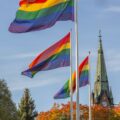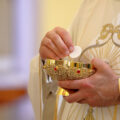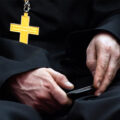The history of ‘conversion therapies’
The history of ‘conversion therapies’
Christian churches have a history of homophobia. Clémence Sauty interviews Anthony Favier, historian of Christian ‘conversion therapies’.
This weekly comment was written by Clémence Sauty and reflects her personal analyses and opinions, rather than those of EARS.
So-called ‘conversion therapies’ are becoming a hot topic in Europe. This expression serves to identify “any practice, behaviour, or repeated remarks aiming at changing or suppressing someone’s sexual orientation or gender identity.”[1] ‘Conversion therapies’ range from invasive comments to torture.[2] [3] [4] [5] They specifically target LGBTQ+ people.
The Dutch, British, and French Parliaments are currently on the verge of prohibiting these practices. Germany and Malta already have.[6] The security of LGBTQ+ people of faith has become a political concern. However, this would not have been possible if no evidence of the harm had been collected.
In this article, I will interview French historian Anthony Favier.[7] He specifically focuses on anti-LGBTQ+ programs.[8] How and why does he work on a history of Christian ‘conversion therapies’?
Clémence Sauty: Some historians fight the erasure of LGBTQ+ people from history. The necessity to archive tracks of queer lives and works is a long-lasting debate.[9] Has there ever been such a controversy on preserving the historical data from LGBTQ+ Christian existences?
Anthony Favier: When I used to co-chair the LGBTQ+ Christian association David & Jonathan,[10] me and my peers were faced with this delicate question. It was preferable that LGBTQ+ associations stored and managed our archives. They were the ones most apt to control their valorisation. But the project of an LGBTQ+ house of the archives in Paris never went through.
Still, we had collected a lot of documents and many historians asked to access them for their research. We therefore chose to place them in the National Archives. Since then, they have been consulted many times. For example, British historian Dan Calwood cited these archives in his work on the evolution of the social status of homosexual men in France.[11]
CS: When did you begin archiving this data and doing contemporary history? What were your motivations then?
AF: In the beginning, I did not aim at archiving data. I rather wanted to document phenomenons that some religious people argued “did not exist,” or “never existed in France.”
This happened within the debate on ‘conversion therapies’. I found it terribly presumptuous and peremptory to deny the facts. At the time, there was no good research on the topic, and as it happens to any minority group, the experiences of LGBTQ+ Christians were silenced. Out of concern for the truth, I began using the tools I had learned while writing my doctoral thesis to tackle this topic. This helped me highlight intellectual networks and grasp the means by which the practices of ‘deliverance’, ‘counselling’ and ‘healing’ were disseminated.
It also allowed me to keep track of discourses and practices that happened within Christian churches. I had to investigate religious movements from the inside: their ‘grey literature’,[12] their internal magazines, the Youtube channels of neo-pentecostal preachers, etc. Today, this documentation is online and serves to support LGBTQ+ movements and Christian communities in using reliable data, in order to understand what ‘conversion therapies’ are.
CS: You wish to create a factual basis for a change to happen, in regards to how Christian churches address ‘conversion therapies’. What changes do you hope and work for?
In France, at the beginning of the 2010s, denouncing ‘conversion therapies’ was really marginal! The public opinion, whether Christian or not, had no idea what this expression meant. And even when explained, the vast majority did not perceive that ‘conversion therapies’ could be a problem, since “people supposedly agreed to undergo such treatment.”
A major turn happened in 2019. A documentary named Homothérapie[13] and a book titled Dieu est amour[14] [God is love] drew a lot of attention. The topic became political. A year earlier, deputy Laurence Vanceunebrock-Miallon had already proposed a law banning ‘conversion therapies’.[15] This law will imminently be adopted by the Parliament.[16]
I shared my expertise in this process. And I was certainly not the only one participating in this change! Now that the association of victims Rien à Guérir [Nothing to heal] was created, I think it is necessary that we centre the expertise and requests of the victims themselves. It is now their cause. I gladly settle for a supporting role.
CS: Some researchers claim to be neutral. Others acknowledge their personal preferences. As a historian of anti-LGBTQ+ religious practices and discourses and also as a gay Catholic, how do you manage your different identities?
AF: I have a balanced position on this question. On the one hand, I think that we need to keep an ideal of objectivity and universality when we produce knowledge. This involves quoting sources, explaining methodological choices, and accepting critical discussion with our peers. I dare to believe that all reasonable and well-intended people can find common ground in intellectual deliberation.
On the other hand, I recognise that no reasoning is neutral and that ‘neutrality’ can serve to ‘neutralise’ the testimony of minority groups. For me, honesty is key. I do not hide my commitments and convictions. I would sometimes like my opponents to do the same! In Christian churches, people like me are easily accused of belonging to a pseudo ‘LGBT lobby’, while our interlocutors do not express their own belongings and interests.
Yes, I am a Christian, among others, who affirms that the 1992 catechism of the Catholic Church is homophobic. I further assert that its articles on homosexuality must be abrogated.[17] And I ask theologians to re-assess the place of men and women in the Bible.
CS: How do Christian churches and history faculties receive your research on ‘conversion therapies’?
AF: I still cannot measure the impact of my work.
On the academic side, I am regularly asked to participate in research projects. Within the academy, there is a concern for documenting these phenomenons.
In religious spaces, the reception of my work is probably more contrasted. I cannot say that I cause outright hostility. My work interests the liberal wing of protestant churches and some parts of Catholicism.
Not only that: I met with a charismatic church that had invited a Catholic preacher who pretends that he “delivers homosexuals.” We could not find an agreement as to the dangerosity of such practices. Still, they took my perspective into account and actively listened. They ended up asking themselves how they could make their events more inclusive. Could this be the beginning of something?
Thank you, Anthony Favier, for answering my questions! This interview will be followed by a commentary on commemorations policies within Christian churches.
This weekly comment was written by Clémence Sauty and reflects her personal analyses and opinions, rather than those of EARS.
Interested in similar topics? Go to our Dashboard and receive free updates.
[1] Proposition de loi interdisant les pratiques visant à modifier l’orientation sexuelle ou l’identité de genre d’une personne
[2] HCDH | Les « thérapies de conversion » et les droits de l’homme
[3] Thérapies de conversion : petit bilan de l’année 2020 – Le blog d’Anthony Favier
[4] L’Assemblée vote l’interdiction des «thérapies de conversion» et un nouveau délit pour les punir
[5] Viols “correctifs”, médicaments, isolement… les ravages des “thérapies de conversion” pour homosexuels
[6] L’Assemblée vote l’interdiction des «thérapies de conversion» et un nouveau délit pour les punir
[8] Thérapies de conversion : petit bilan de l’année 2020 – Le blog d’Anthony Favier
[9] Archives LGBT+, retrouver la mémoire – Ép. 4/4 – Histoires d’archives
[10] Présentation de David & Jonathan, association LGBTI+ (Lesbienne, Gay, Bi, Trans, Intersexe) chrétienne
[11] Re-evaluating the French Gay Liberation Moment 1968-1983 Dan Callwood School of History Queen Mary, University of London Submi
[12] Grey literature – Wikipedia
[13] Available in French and German: Homothérapies, conversion forcée – Regarder le documentaire complet | ARTE
[14] Jean-Loup Adénor, Thimothée de Rauglaudre, Dieu est amour – Infiltrés parmi ceux qui veulent “guérir” les homosexuels, Flammarion, 2019
[15] Proposition de loi interdiction thérapies de conversion LGBT+
[16] La loi interdisant les thérapies de conversion adoptée à l’unanimité
[17] For example, Paragraph 2357 of the Catechism of the Catholic Church states: “Homosexuality refers to relations between men or between women who experience an exclusive or predominant sexual attraction toward persons of the same sex. (…) Basing itself on Sacred Scripture, which presents homosexual acts as acts of grave depravity, tradition has always declared that “homosexual acts are intrinsically disordered.” They are contrary to the natural law. They close the sexual act to the gift of life. They do not proceed from a genuine affective and sexual complementarity. Under no circumstances can they be approved.” See here: Catechism of the Catholic Church






